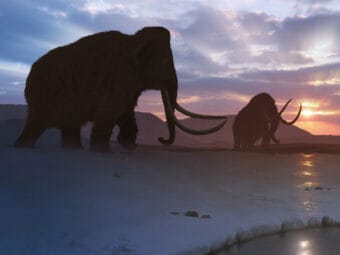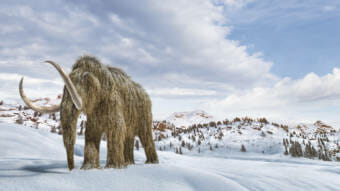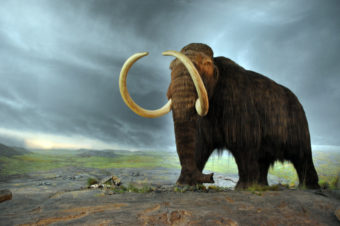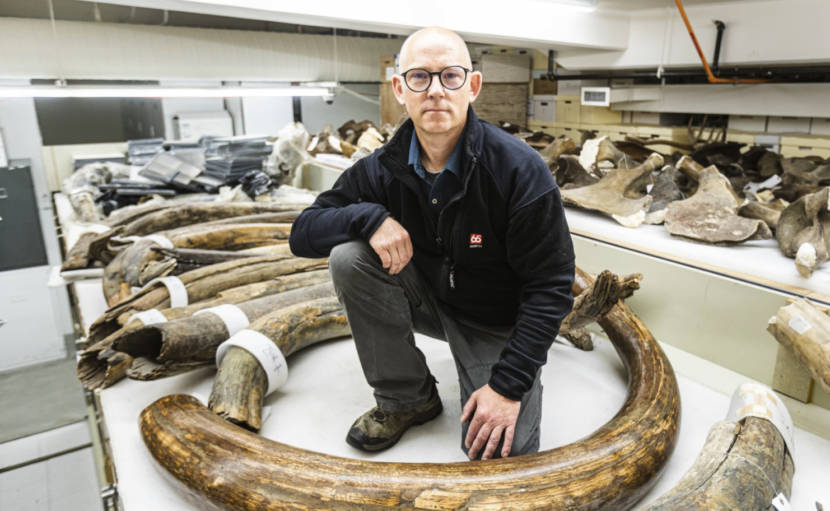
Chemical analysis of a 14,000-year-old woolly mammoth tusk found that the animal, a healthy female that trekked about 1,000 kilometers (600 miles) from Canada’s Yukon Territory before dying at 20 in Interior Alaska, had territory that overlapped that of early humans.
The chemical fingerprints in the tusk, combined with DNA analysis of the bones of two young mammoths found in the area, create a compelling case that the people who lived in Pleistocene-era Alaska hunted the giant animals, according to research led by University of Alaska Fairbanks scientists. The findings are detailed in the journal Science Advances.
The mammoth was discovered in 2009 and named Élmayųujey’eh, or Elma for short. The name, bestowed by the Healy Lake Tribal Council of Interior Alaska, translates to something not beautiful but very striking in appearance.
Found along with Elma’s tusk were remains of two juvenile mammoths – the ribs that held meat known to be used elsewhere by ancient humans. They died near a spot along the Tanana River known as Swan Point, which is the earliest confirmed human habitation site in Alaska. Isotope analysis of the tusk shows a life’s journey that began in the vicinity of ancient human settlements in Canada.
Though there is not a “smoking gun” showing that Elma was killed by hunters, there is a “preponderance of data” supporting that conclusion, said Matthew Wooller, a coauthor and director of the Alaska Stable Isotope Facility at UAF, where the chemical analysis was conducted. Elma’s journey started in the vicinity of known sites of ancient human habitation in Canada and ended abruptly in the vicinity of a known human habitation site in Alaska, where campsites hold evidence of hunting in general, such as remains of other animals and blades typically used in hunting. “So it’s just uncanny to us,” Wooler said.
The reconstruction of Elma’s life journey provides valuable information for modern animals now roaming the same territory that she trod. It is a warning sign for conservation of critically endangered large animals like rhinos, said Audrey Rowe, a UAF PhD student who is the study’s lead author.
“Really, my takeaway is that large animals are so much more fragile in terms of extinction than smaller ones,” Rowe said. “You see this over and over again throughout the history of the planet.”
She cited the way that non-avian dinosaurs disappeared but tiny mammals that were scurrying around the planet at the same time endured. The pattern continued through the end of the last Ice Age and into modern times, she said. Larger animals that take longer to reproduce are “not resilient against sudden changes,” she said.
For woolly mammoths, the reasons for extinction continue to be debated. Were they victims of climate change, or were they hunted into oblivion by ancient humans?
Rowe said does not belong to either “camp climate change” or “camp overkill.”
It is unlikely that mammoths would have survived in Alaska, at least, even if there were no people, she said. But overhunting could have contributed to the demise, especially considering how long it took them to reproduce. They reached sexual maturity at about 15 years, and their gestation period was about 22 months, she said.
“So killing one mammoth is a bigger impact on the population than killing one bison or one moose or one caribou just because of that much longer period of time that it takes for them to reproduce,” she said
Elma’s fate was different from that of a different Alaska woolly mammoth that trod much of the same ground about 3,000 years earlier, a male named Kik. Previous isotope analysis of his tusk, also done by the UAF team, traced his wanderings in Interior Alaska and through the Brooks Range until he died, alone, of starvation at about age 28. Those findings were released in 2021.
There were some revealing differences between Elma’s travels and those made by Kik. Elma chose more high-elevation areas, which made sense because the climate changed significantly in the 3,000 years since Kik’s travels. By the time Elma was on the scene, warming had caused lower elevations to be wetter, soggy and brushier, making it more difficult for such large animals to navigate than the steppe-dominated landscape of Kik’s time, Wooller said.
“For anybody that has done any walking about in Alaska, you know, the last place you’d want to be walking about, during summer certainly, is down in the kind of swampy lowlands, the muskeg and the like,” he said.
All those movements could be tracked back in time in the layers of Elma’s and Kik’s tusks. Mammoth tusks, which grew in layers at consistent rates throughout the animals’ lifetimes, turn out to be excellent recorders of history, matching what the animals ate to the varied geologic structures across Alaska, which have their own chemical fingerprints, Wooller said.
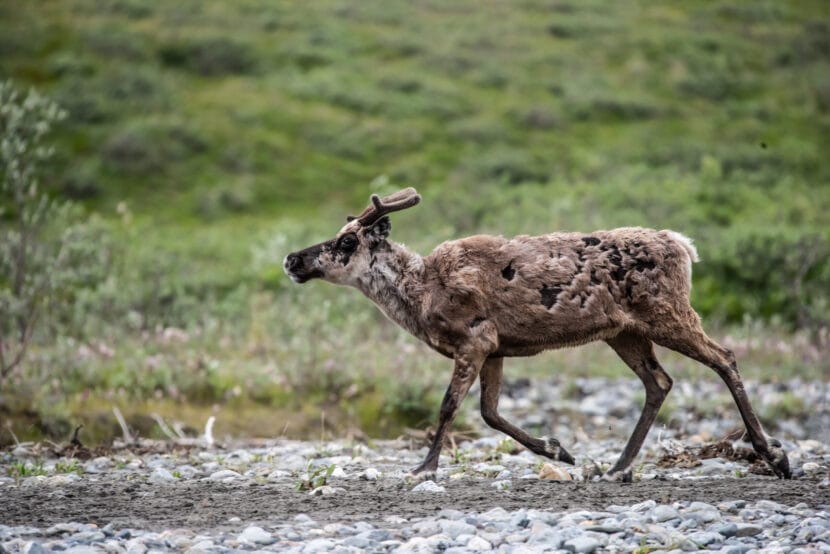
The findings about Elma, on top of those about Kik, are proving useful for another animal that travels long distances over Arctic Alaska terrain: caribou.
Like the extinct mammoths, caribou depend on a climate that is changing rapidly, becoming less hospitable as woody shrubs spread north and displace the tundra plants that caribou normally eat.
Caribou are not in danger for now, as they reproduce quickly and have the benefit of modern wildlife monitoring and management, Rowe said. But there are some potential trouble signs, she said.
“If the entirety of Alaska starts to be covered in boreal forest or maybe even if more temperate climates start to creep northward into where we live, that would not be ideal for caribou and we might see a lot more moose, a lot less caribou perhaps,” she said.
As part of her research into ancient caribou and reconstruction of herd movements, Rowe is using isotope analysis of teeth that is similar to what has been used on the woolly mammoth tusks. She is comparing modern teeth from the Fortymile herd with teeth from ancient caribou that used the same territory. Part of her work will be to determine whether the ancient and modern caribou are linked or are completely different biologically, as well as determining if they have been ranging over the same territory for thousands of years or have made changes in their travels.
Analysis of the teeth is more challenging than that performed on the much-bigger mammoth tusks, Rowe said. Unlike mammoth tusks, caribou teeth grow at uneven rates and stop growing entirely after the animals’ first two years of life.
There are other key differences, aside from the obvious fact that caribou are still here while mammoths are not.
Mammoths didn’t really migrate in the sense that biologists use the word, she said. They traveled around a lot to find food, but they did not use regular seasonal back-and-forth pathways.
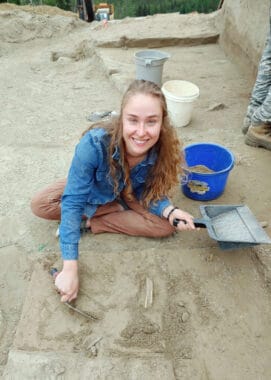
Mammoths were among those animal species with small feet for body size, which appears to be a feature that helped doom certain Pleistocene animal species that were not able to adapt to post-Ice Age change to a warmer climate with more swampy terrain and more snow. Like mammoths, extinct woolly rhinos and ancient Pleistocene horses that once roamed northern Alaska had small feet relative to their body weight, while caribou, moose and muskoxen and other animals with feet large enough to spread out body weight more effectively on soft surfaces are still here.
The string of ancient human sites along the Tanana River, aside from suggesting hunting of mammoths that regularly traveled that corridor, show how habitat changed over thousands of years. There was a shift from a heavy reliance on big Pleistocene mammals during Elma’s time to more bison and elk about 1,000 years later to a much heavier reliance on caribou starting about 6,000 years ago.
Elsewhere along the Tanana River corridor, though not at Swan Point specifically, is evidence of ancient people eating salmon. The oldest archaeological evidence of salmon consumption was found at a site known as Upward Sun River. There, 11,500-year-old chum salmon bones found by UAF anthropologist Ben Potter, also a coauthor of the study about Elma, showed how ancient people started a shift into fishing.
While changes in the landscape are believed to have driven mammoths into oblivion, their disappearance could have also changed the landscape. Through grazing and tramping on the ground, they put a check on the spread of vegetation and helped preserve permafrost freeze, Wooller said. “And so the removal of ecosystem engineers would certainly have had an impact, for sure,” he said.
Partly because of that and partly because of the general fascination with the ancient creatures, there are efforts to resurrect the species. Wooller is a scientific adviser to one company, Colossal Laboratories and Biosciences, that is seeking to reestablish mammoths or mammoth-like cold-climate elephants to help restore far-north grasslands like those of the past, which it describes as better carbon sinks than the current mossy and forested terrain that has succeeded the mammoths’ era. There are other companies, in the United States and in Korea, that are pursuing the same goal. Possible methods could use ancient DNA and replicate it through cloning or employ some sort of artificial insemination with modern elephants. Another project, Pleistocene Park in Siberia, is focused on recreating the steppe ecosystem that supported the extinct mammoths, using large grazers like bison and muskoxen to do so.
Rowe is skeptical that Alaskans would welcome giant elephant-like creatures stomping around the state’s Arctic landscape in the modern era. But if not practical for Alaska, the idea is more intriguing for a different location, like Siberia or Mongolia.
“I personally think it would be really cool to be able to see a mammoth or something close to it again,” she said. “Maybe not necessarily here, but I certainly, I would certainly take a trip to Pleistocene Park to see it if that were to happen someday.”
This story originally appeared in the Alaska Beacon and is republished here with permission.

